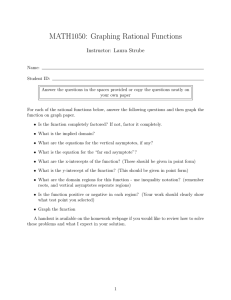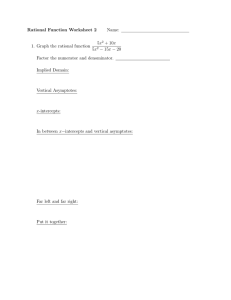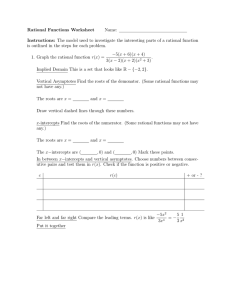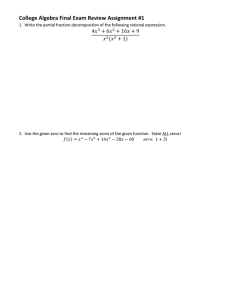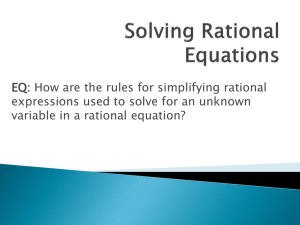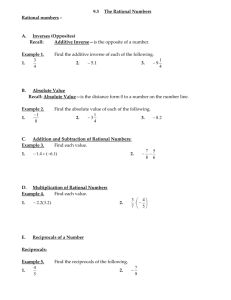Reciprocals of Linear Functions Reciprocals of
advertisement
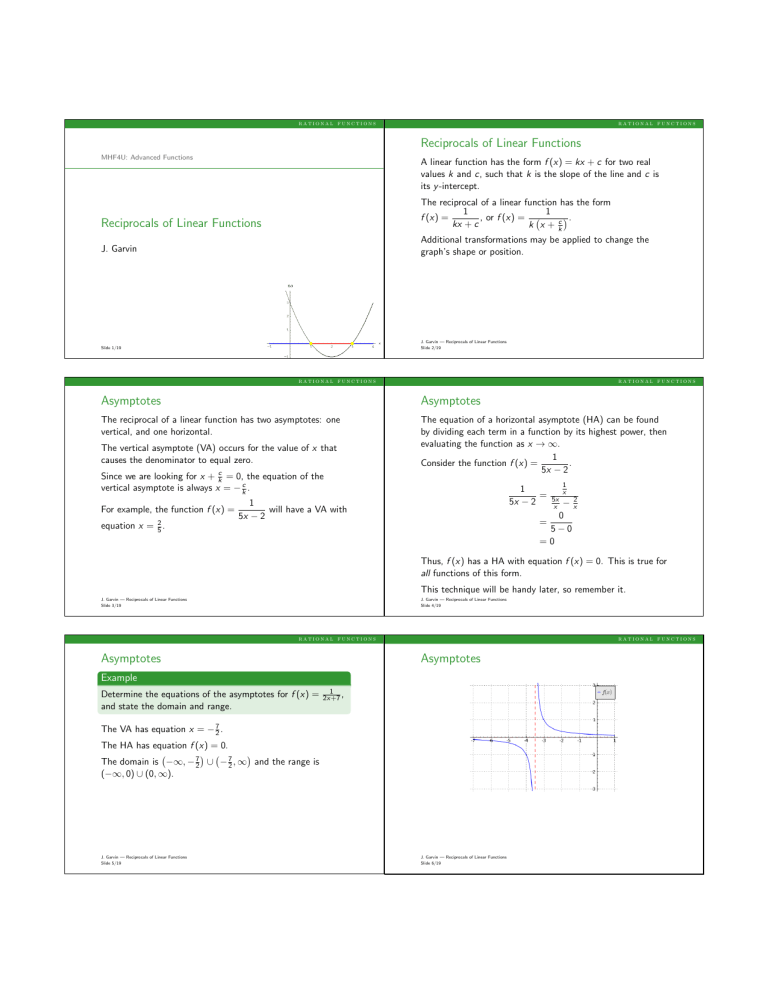
rational functions rational functions Reciprocals of Linear Functions MHF4U: Advanced Functions A linear function has the form f (x) = kx + c for two real values k and c, such that k is the slope of the line and c is its y -intercept. The reciprocal of a linear function has the form 1 1 . f (x) = , or f (x) = kx + c k x + kc Reciprocals of Linear Functions Additional transformations may be applied to change the graph’s shape or position. J. Garvin J. Garvin — Reciprocals of Linear Functions Slide 2/19 Slide 1/19 rational functions rational functions Asymptotes Asymptotes The reciprocal of a linear function has two asymptotes: one vertical, and one horizontal. The equation of a horizontal asymptote (HA) can be found by dividing each term in a function by its highest power, then evaluating the function as x → ∞. 1 Consider the function f (x) = . 5x − 2 The vertical asymptote (VA) occurs for the value of x that causes the denominator to equal zero. Since we are looking for x + kc = 0, the equation of the vertical asymptote is always x = − kc . 1 = 5x − 2 1 x − x2 0 = 5−0 =0 1 For example, the function f (x) = will have a VA with 5x − 2 equation x = 25 . 5x x Thus, f (x) has a HA with equation f (x) = 0. This is true for all functions of this form. This technique will be handy later, so remember it. J. Garvin — Reciprocals of Linear Functions Slide 3/19 J. Garvin — Reciprocals of Linear Functions Slide 4/19 rational functions Asymptotes rational functions Asymptotes Example Determine the equations of the asymptotes for f (x) = and state the domain and range. 1 2x+7 , The VA has equation x = − 27 . The HA has equation f (x) = 0. The domain is −∞, − 72 ∪ − 27 , ∞ and the range is (−∞, 0) ∪ (0, ∞). J. Garvin — Reciprocals of Linear Functions Slide 5/19 J. Garvin — Reciprocals of Linear Functions Slide 6/19 rational functions Asymptotes rational functions Asymptotes Example Determine the equations of the asymptotes for f (x) = and state the domain and range. 2 4x−9 , The VA has equation x = 49 . The HA has equation f (x) = 0. The 2 in the numerator stretches the graph, but does not change its location. The domain is −∞, 49 ∪ 94 , ∞ and the range is (−∞, 0) ∪ (0, ∞). J. Garvin — Reciprocals of Linear Functions Slide 8/19 J. Garvin — Reciprocals of Linear Functions Slide 7/19 rational functions rational functions Intercepts Intercepts As with any function, f (x)-intercepts can be found by setting x = 0 in its equation. a Since a function of the form f (x) = has a horizontal kx + c asymptote at f (x) = 0, such functions have no x-intercepts. Example Determine the intercepts for f (x) = 1 . x −2 Evaluate f (0) to find the f (x)-intercept. Vertical translations will shift a graph and its horizontal asymptote, resulting in exactly one x-intercept. 1 0−2 = − 12 f (0) = Since there are no vertical translations, there are no x-intercepts. J. Garvin — Reciprocals of Linear Functions Slide 9/19 J. Garvin — Reciprocals of Linear Functions Slide 10/19 rational functions Intercepts rational functions Intercepts Example Determine the intercepts for f (x) = 1 + 2. x +5 Evaluate f (0) to find the f (x)-intercept. 1 f (0) = +2 0+5 = 11 5 To determine the x-intercept, set f (x) = 0 and solve for x. 1 0= +2 x +5 − 2(x + 5) = 1 x + 5 = − 21 J. Garvin — Reciprocals of Linear Functions Slide 11/19 J. Garvin — Reciprocals of Linear Functions Slide 12/19 x = − 11 2 rational functions rational functions Intercepts Intervals of Increase and Decrease Since there has been a vertical translation of 2 units up, the horizontal asymptote has equation f (x) = 2. The graph of f (x) = There is a vertical asymptote at x = −5. When a > 0, one branch is upper right and the other lower left. symmetric branches. a is a hyperbola, with two kx + c If a < 0, there has been a vertical reflection and the branches are in the lower right and upper left. Along with information about the asymptotes, this can be used to identify intervals of increase and decrease. J. Garvin — Reciprocals of Linear Functions Slide 13/19 J. Garvin — Reciprocals of Linear Functions Slide 14/19 rational functions rational functions Intervals of Increase and Decrease Intervals of Increase and Decrease Example Since f (x) = −4 1 , a < 0, so the function has x −3 branches in the upper left and lower right. 4 : x −3 • Determine the equations of the asymptotes Given f (x) = − As x → 3 from the left, f (x) → ∞. Therefore, f (x) is increasing on (−∞, 3). • Determine the locations of the intercepts • State the intervals on which the function is increasing or decreasing • State the intervals on which the slope is increasing or decreasing As x → ∞, f (x) → 0 from below. Therefore, f (x) is increasing on (3, ∞). In general, the reciprocal of a linear function is always increasing when a < 0, and always decreasing when a > 0. There are asymptotes at x = 3 and f (x) = 0. The f (x)-intercept is at 43 . There is no x-intercept. J. Garvin — Reciprocals of Linear Functions Slide 15/19 J. Garvin — Reciprocals of Linear Functions Slide 16/19 rational functions Intervals of Increase and Decrease rational functions Intervals of Increase and Decrease Since the left branch becomes steeper upwards as we move from left to right, the slope is increasing as x → 3 from the left. Since the right branch becomes less steep as we move from left to right, the slope is decreasing as x → ∞. Therefore, the slope is increasing on (−∞, 3) and decreasing on (3, ∞). It is important to remember the difference between the function increasing, and its slope increasing, as they are often different. J. Garvin — Reciprocals of Linear Functions Slide 17/19 J. Garvin — Reciprocals of Linear Functions Slide 18/19 rational functions Questions? J. Garvin — Reciprocals of Linear Functions Slide 19/19
